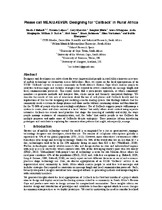| dc.contributor.author | Bidwell, Nicola J. | |
| dc.contributor.author | Lalmas, Mounia | |
| dc.contributor.author | Marsden, Gary | |
| dc.contributor.author | Dlutu, Bongiwe | |
| dc.contributor.author | Ntlangano, Senzo | |
| dc.contributor.author | Manjingolo, Azola | |
| dc.contributor.author | Tucker, William David | |
| dc.contributor.author | Jones, Matt | |
| dc.contributor.author | Robinson, Simon | |
| dc.contributor.author | Vartiainen, Elina | |
| dc.contributor.author | Klampanos, Iraklis | |
| dc.date.accessioned | 2014-03-10T14:25:04Z | |
| dc.date.available | 2014-03-10T14:25:04Z | |
| dc.date.issued | 2011 | |
| dc.identifier.citation | Bidwell, N. J., et al. (2011). Please call ME.N.U.4EVER: designing for “Callback” in rural Africa. International Workshop on Internationalisation of Products and Systems (IWIPS), pp. 117–137, Kuching, Malaysia | en_US |
| dc.identifier.isbn | 0-9722184-6-7 | |
| dc.identifier.uri | http://hdl.handle.net/10566/1053 | |
| dc.description | Proceedings of the Tenth International Workshop on Internationalisation of Products and Systems. Kutching, Malaysia, 11-14 July, 2011 | |
| dc.description.abstract | Designers and developers are naïve about the ways impoverished people in rural Africa innovate new uses of mobile technology to circumvent access difficulties. Here, we report on the local appropriation of an USSD ‘Callback’ service in a rural community in South Africa’s Eastern Cape which enables people to send free text messages and includes strategies that respond to severe constraints on message length and local communication protocols. This report shows that a participative approach, in which community members co-generate methods and interpret data, elicits major and formerly unreported findings. We describe the results of two sets of interviews about the use of cell-phones and Callback locally and the implications of this use for designing and realizing a media-sharing system. Our findings indicate that the community needs a system to charge phones and share media without consuming airtime and functionality for the 70-80% of people who do not own high-end phones. Use of Callback suggests people will manage a system to create, store and share content at a local ‘station’ but notify others about content using separate networks. Callback-use reveals local priorities that shape: the meaning of usability and utility; the ways people manage sequences of communication; and, the ‘rules’ that enable people to use Callback for multiple purposes and make sense of Callbacks despite ambiguity. These priorities inform introducing prototypes and contribute to exploring the communication patterns that might, subsequently, emerge. | en_US |
| dc.description.sponsorship | EPSRC | en_US |
| dc.language.iso | en | en_US |
| dc.publisher | Product & Systems Internationalisation, Inc | en_US |
| dc.rights | Copyright Product & Systems Internationalisation, Inc | |
| dc.subject | ICT design methodology | en_US |
| dc.subject | ICT for development | en_US |
| dc.subject | Participatory design | en_US |
| dc.title | Please call ME.N.U.4EVER: designing for “Callback” in rural Africa | en_US |
| dc.type | Conference Proceedings | en_US |
| dc.privacy.showsubmitter | FALSE | |
| dc.status.ispeerreviewed | TRUE | |
| dc.description.accreditation | Department of HE and Training approved list | en_US |

